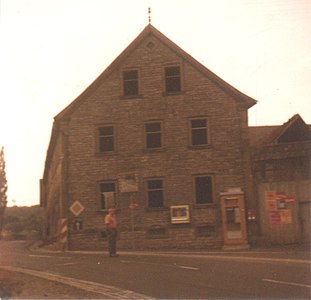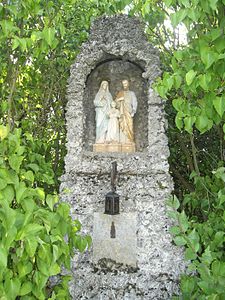Rütschenhausen
|
Rütschenhausen
Community Waterless
Coordinates: 50 ° 3 ′ 39 ″ N , 10 ° 3 ′ 24 ″ E
|
|
|---|---|
| Height : | 299 m |
| Area : | 3.27 km² |
| Residents : | 175 (1988) |
| Population density : | 54 inhabitants / km² |
| Incorporation : | May 1, 1978 |
| Postal code : | 97535 |
| Area code : | 09726 |
Rütschenhausen is a part of the municipality Wasserlosen in the district of Schweinfurt in the district of Lower Franconia ( Bavaria ).
geography
The place is on the open ground in Franconia , about 13 km west of Schweinfurt .
In the north is Greßthal , in the west Schwemmelsbach , in the east Sommersdorf , in the north-east Obbach , in the south-east Brebersdorf and in the south Kaisten .
history
The settlement beginnings of the place go back to the time of the second Franconian conquest of the Carolingians in the 9th century. On April 28, 906 Ruodsuvinduhusen was named. Adalbertus comes provincialis exchanged certain goods with the Fulda abbot Huoggi . This was done in agreement with King Ludwig the child . Another source dates this document to 907, although the spelling of the place name with Ruotsuvindeshusen also shows a change. However, there are also sources related to the Babenberg feud that date the death of Adalbertus on September 9, 906.
In 953, Count Rudolf von Saalgau concluded an exchange with Abbot Hadamar von Fulda , which King Otto confirmed in 958. The Fulda monastery handed over properties in Rutsindehusen.
Rütschenhausen came early to the high estates court and office of Arnstein, founded in 1292 . The most important landlord was now the Würzburg monastery . The high and the lower courts took the bishop true.
Originally, Rütschenhausen was a branch of the parish Altbessingen. The church in Rütschenhausen, an old pilgrimage site to Maria von der Tann , is said to go back to the 13th century. In 1443 Rütschenhausen was assigned to the newly founded Upper Parish Greßthal.
In 1449 the abbot Anna Kuchenmeister and her convent of the Frauenroth monastery sold their tithes in the field and in the village of Kaisten, big and small, to the Cappeln our dear frawen zu Rutzenhusen for 26 guilders in Rhenish currency .
In 1574 the Reichtalsdörfer Greßthal, Rütschenhausen, Brebersdorf, Kaisten and Schwemmelsbach together formed a village court. It had two judges and twelve lay judges .
In 1598 the steeple of the pilgrimage church was rebuilt and the nave was rebuilt in 1659. The different dates 1600 and 1615 indicate that the building has been rebuilt several times. In 1712 the pilgrimage church was extended by an axis to the west.
After secularization , the village was assigned to the Arnstein district court in 1804, became part of the Grand Duchy of Würzburg , established in 1806, and became Bavarian in 1814 . In 1862 the judiciary and administration were separated. The previous district courts of Arnstein and Karlstadt were retained for jurisdiction. The two former regional courts were combined to form the Karlstadt District Office .
Rütschenhausen was the municipality that was furthest forward to the northeastern border, and the district offices of Schweinfurt and Hammelburg bordered it. Karlstadt is 38 kilometers, Schweinfurt 14 kilometers away. For Rütschenhausen, the long way to the offices was very unfavorable. Since the establishment of the Karlstadt District Office, Rütschenhausen's population has stagnated , although the number of residential buildings has increased.
On April 9, 1945 (the day after White Sunday ) the American army marched into Rütschenhausen. In the days before, artillery fire from the German Wehrmacht (from Hambach ) had killed three cows, damaged a house gable , shot down two poplars and destroyed a window in the church. At the end of the Second World War, Rütschenhausen had a population of 171 people who were killed or missing.
Due to the district reform , which came into force on July 1, 1972, Rütschenhausen was incorporated into the Schweinfurt district.
On May 1, 1978, Rütschenhausen was merged with Brebersdorf , Burghausen , Greßthal , Kaisten , Schwemmelsbach , Wasserlosen and Wülfershausen to form the municipality of Wasserlosen and lost its independence as a municipality. The new municipality of Wasserlosen has its seat in Greßthal.
In 2006 the 1100 year anniversary was celebrated.
Population development
- 1910: 167
- 1933: 195
- 1939: 173
- 1961: 164
- 1970: 168
- 1988: 175
legend
It is reported from the elderly in Rütschenhausen that during a famine the Rütschenhäuser are said to have exchanged a piece of forest called Schnellert with the Kaistenern for a loaf of bread .
politics
mayor

Alfons Wolz was used by the US Army after World War II. If the war had lasted a few days longer, it would have been brought to the concentration camp by the National Socialists.
Local partnerships
There has been a partnership with Ritschenhausen in Thuringia since the collapse of the GDR .
Culture and sights
Attractions
- The pilgrimage church Maria von der Tann has two very old bells. The small bell from 1503, dedicated to St. Mary, has a diameter of 79 centimeters and the big bell from 1520, consecrated to St. John, is 86 centimeters. It was brought home to great cheers in 1947 from the bell cemetery near the port of Hamburg , where it was to be melted down for war purposes. A special feature is that the tower is younger than the bells and dates from 1598. The origin of the name Maria von der Tann goes back to the fact that the Virgin Mary is said to have spoken in a vision of a Christmas tree. During a renovation around 1960, the side altars were removed and probably also the access to the pulpit, which bears the year 1593 above the Julius coat of arms. On September 13, 1987 the new altar was consecrated by Auxiliary Bishop Alfons Kempf and on June 16, 1996 the new church organ was consecrated by Auxiliary Bishop Helmut Bauer .
- Four Corpus Christi altars ( Matthew , Mark , Luke , Johannes )
Wayside shrine from 1607
- The cemetery cross dates from 1852.
- War memorial
|
St. Maria |
- Easter fountain
- Since April 2011 there is a German-American post-war museum in Rütschenhausen
- There is a library in the DJK-Heim, which is open for a few hours on Sundays.
societies
- DJK (founded October 8, 1978)
- Volunteer Fire Brigade (founded on July 7, 1901)
- Eigenheimer (founded October 1983)
- Stammtisch 1982
Buildings
- The morgue was built in 1985 according to the plans of the engineering office Karl Krämer from Sömmersdorf. In 1988, a wall sculpture by the artist from Randersacker Georg Mützel was hung in it.
- Fire station (since May 1981)
- Rütschenhausen oven
- The Stern Gasthaus was demolished on November 4, 1976. The former country inn with a "foreign stable", which was used to store horses, was opened on October 8, 1875. In the early days, the Rütschenhausen post office was also located there.
Regular events
Every year in July / August the so-called fish festival takes place.
The so-called battle bowl is around carnival time every year.
A dark beer evening and a town hall meeting , there is also an annual basis.
The elderly day is always in December.
The solstice fire is celebrated around June 24th.
dialect
In Rütschenhausen, Lower Franconian is mainly spoken, which is one of the Main Franconian dialects .
| Rütschenhausen dialect | Standard German |
|---|---|
| I ho aa ä ü. | I also have an egg left. |
| go nias | There is nothing |
| sou öbbes! | like this! |
| Grumbles | Potatoes |
| Huh | hay |
| Aweed | Eicherer |
| Versanerli | Beans |
Economy and Infrastructure
Economy including agriculture and forestry
Rütschenhausen is characterized by agricultural operations. Most residents commute to the city of Schweinfurt to work.
traffic
Rütschenhausen is located directly at junction 98 “Wasserlosen” on the A 7 (E 45) motorway . The section of the motorway on which Rütschenhausen is located was opened in July 1968 by the then Bavarian Minister of the Interior, Bruno Merk, and the Hessian Minister of Economics and Transport, Rudi Arndt .
The B 303 (U 62 / U 55) goes directly through Rütschenhausen.
There is a bus connection (No. 8139) operated by Omnibusverkehr Franken GmbH (OVF) to Schweinfurt.
At the beginning of 2008 the construction of the Sömmersdorf-Rütschenhausen cycle path was decided and should be completed by the end of 2008.
education
Until 1973/74 Rütschenhausen had its own school, in which up to 45 schoolchildren were sometimes taught on 27 m². The former school building now serves as a clubhouse.
Honorary citizen
- Erwin Ammann (District Administrator) was made an honorary citizen by the then Mayor Alfred Fischer.
literature
- Codex Diplomaticus Fuldensis ( [1] )
Individual evidence
- ↑ a b Schweinfurter Tagblatt dated September 11, 1987
- ↑ a b c Federal Statistical Office (ed.): Historical municipality directory for the Federal Republic of Germany. Name, border and key number changes in municipalities, counties and administrative districts from May 27, 1970 to December 31, 1982 . W. Kohlhammer GmbH, Stuttgart / Mainz 1983, ISBN 3-17-003263-1 , p. 753 .
- ↑ Municipal register Germany 1900, District Office Karlstadt
- ^ Michael Rademacher: German administrative history from the unification of the empire in 1871 to the reunification in 1990. (former) district of Karlstadt. (Online material for the dissertation, Osnabrück 2006).
- ↑ a b c Chronicle of the Wasserlosen community
- ↑ Schweinfurter Tagblatt from September 15, 1987
- ↑ Schweinfurter Tagblatt of June 17, 1996
- ↑ a b c d e monuments in the district of Schweinfurt
- ↑ Schweinfurter Tagblatt of April 16, 2011: Post-War Museum (41 photos)
- ↑ Schweinfurter Tagblatt dated December 9, 2011: Rütschenhausen: Large rush in the newly renovated library
- ↑ Schweinfurter Tagblatt of July 9, 2001.
- ↑ Schweinfurter Tagblatt of July 31, 1985.
- ↑ Schweinfurter Tagblatt of November 5, 1988.
- ↑ Schweinfurter Tagblatt of May 29, 1981.
- ↑ Schweinfurter Tagblatt of November 12, 1976.
- ↑ Schweinfurter Tagblatt of July 30, 1968 - special supplement.
- ↑ Schweinfurter Tagblatt of April 27, 2008
Remarks
- ↑ The Kreuzschlepper used to be on the right-hand side at the exit of Rütschenhausen in the direction of Greßthal and was moved to its current location sometime after the First World War .
- ↑ The restoration was carried out in 1981/1982 by the sculptor Peter Vollert from Üchtelhausen
- ↑ The wayside shrine has the same stonemason's mark as the pulpit in the Rütschenhausen church









